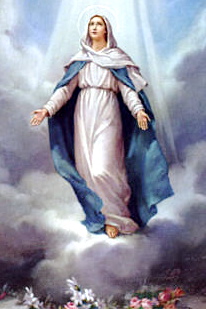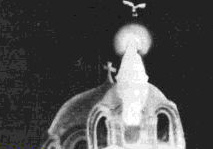Blessed Virgin Mary
|
|

A traditional Catholic picture sometimes displayed in homes. It may be displayed as part of a set. For accompanying image, see the Sacred Heart.
The Blessed Virgin Mary, sometimes shortened to The Blessed Virgin, is a traditional title specifically used by Roman Catholics, Anglo-Catholics and others to describe Mary, the mother of Jesus. It carries with it a belief not merely in the virginity of Mary, but of her continuing role within the church and in the life of ordinary Catholics, for which Roman Catholicism in the Dogmatic Constitution of the Church (21 November 1964) passed during the Second Vatican Council granted her the title Advocate, Auxiliatrix, Adjutrix, and Mediatrix. Colloquially she may be refered to as The BVM.
| Contents |
The Blessed Virgin Mary in Catholicism
Whereas Protestants often tend to see Mary as a passive historical figure, Catholicism and Orthodoxy focus on her as a living person who can intercede with her son, Jesus Christ, on behalf of humanity. From the beginning of the Church, Catholic theology has believed that Christ is the Sole Mediator between God and Man (1 Tim 2:5 (http://www.biblestudytools.net/OnlineStudyBible/bible.cgi?word=1+Tim+2%3A5§ion=9&version=rhe&new=1)). Yet as Ludwig Ott observes, "there is nothing to prevent others in a certain way (secundum quid) from being called mediators between God and man, in so far as they, by preparing or serving, cooperate in uniting men to God" (Bk III, Pt. 3, Ch. 3, §7) (emphasis added). Catholic theology proposes that Mary's willed obedience (Lk 1:38 (http://www.biblestudytools.net/OnlineStudyBible/bible.cgi?word=Lk+1%3A38§ion=9&version=rhe&new=1)) is contrasted with Eve's disobedience (Gn 3:6 (http://www.biblestudytools.net/OnlineStudyBible/bible.cgi?word=Gn+3%3A6§ion=9&version=rhe&new=1)), an idea with roots in the writings of the Church Fathers. Mary herself required redemption, and is not equal to Christ in Catholic theology. Nonetheless her role was pivotal, as emphasized by St. Jerome, St. Irenaeus inter A.D. 180–199 (see Jurgens §224), Tertullian c. A.D. 212 (see Jurgens §358) and others including herself in Scripture: "behold the handmaid of the Lord" (emphasis added). Mary is also described by St. Ambrose as "the prototype of the Church"[1] (http://www.marys-touch.com/truth/redeemer.htm).
Marian devotions play a key part in the ritual and liturgy of Western Catholicism and Eastern Orthodoxy, through feast days, special prayers, and hymns. Her centrality has been stressed by popes and saints throughout the centuries. According to St. Bernard of Clairvaux (1090–1153): "[Mary is called] the gate of heaven, because no one can enter that blessed kingdom without passing through her" while St. Bonaventure (1221–1274) wrote: "As the moon, which stands between the sun and the earth, transmits to this latter whatever it receives from the former, so does Mary pour out upon us who are in this world the heavenly graces that she receives from the divine sun of justice."
Marian prayers
The most famous Marian prayer is the Rosary, a form of prayer in which an Our Father, ten Hail Marys and a Glory Be to the Father (together forming a "decade of the Rosary") are recited five times while meditating on the mysteries of the life of Jesus and Mary (Joyful, Luminous, Sorrowful and Glorious) to be followed by a prayer called the "Hail Holy Queen" and perhaps the "Litany of Loretto".
Other famous Marian prayers include the "Magnificat" and the Litany of the Blessed Virgin Mary. Marian hymns include O Mary, we Crown Thee With Blossoms Today, the Regina Coeli, and the Ave Maria. The month of May is usually seen within traditional Roman Catholicism as a Marian month.
Apparitions
The central role of Mary in the belief and practice of Catholicism is reflected in the fact that many Catholic churches contain side altars dedicated to the Virgin Mary. She is also celebrated through major religious sites where it is claimed apparitions or appearances of the Virgin have occurred, often with claims by witnesses that messages to humanity were delivered.
- See: Marian apparitions

Catholic dogma proclaimed under papal infallibility by Pope Pius XII in 1950
The Immaculate Conception
Since the Middle Ages, Catholic theologians had argued the question of whether or not Mary had been subject to original sin. In general, the Franciscans argued in favor of her "immaculate conception", the doctrine that she, from the moment of her conception, had been preserved by God from all sin and all tendency to sin; the Dominicans, on the other hand, including most notably St. Thomas Aquinas, argued that Mary's sinlessness is a grace granted to her at some time after her conception. In 1854, Pope Pius IX effectively ended the debate for Roman Catholics by proclaiming the dogma of the "Immaculate Conception", stating that "the Blessed Virgin Mary in the first instant of her conception was preserved exempt from all stain of original sin by a singular privilege and grace granted by God, in view of the merits of Jesus Christ, the Saviour of the human race." (Ineffabilis Deus, issued on 8 December 1854). It was subsequently claimed that the Blessed Virgin Mary during her first appearance in Lourdes on 11 February 1858 announced to Bernadette Soubirous "I am the Immaculate Conception". The term Immaculate Conception is also widely used within Catholicism to refer to the Virgin Mary.
Dogma of the Assumption
In 1950, using Papal Infallibility, in his encyclical Munificentissimus Deus Pope Pius XII proclaimed the Dogma of the Assumption, in which he stated that "at the end of her earthly course, Mary was assumed into heavenly glory, body and soul". He stated that "holy writers who ... employed statements and various images and analogies of Sacred Scripture to illustrate and to confirm the doctrine of the Assumption..." He also stated that he was relying both on scripture and on "apostolic tradition". As an infallible pronouncement, the Dogma of the Assumption is thus a mandatory belief for Roman Catholics. No pope since has issued an infallible dogma.
Maryaltar2.jpg
in St. Mary's Pro-Cathedral in Dublin
Mary as "co-redeemer"
Some Catholics in the late twentieth century urged Pope John Paul II to infallibly declare Mary a co-redeemer (co-redemptrix) with Jesus. Professor Mark Miravalle of the Franciscan University in Steubenville in the United States launched a petition to urge Pope John Paul to make such a move, by defining the teaching of the Church that Mary is Co-Redemptrix [co-redeemer], Mediatrix [mediator] of All Graces, and Advocate for the People of God. More than six million signatures were gathered from 148 countries. Signaturies included Mother Teresa of Calcutta, Cardinal John O'Connor of New York, 41 other cardinals and 550 bishops. However such a proposal was also heavily criticised by many Catholics who suggested that only Christ could be a redeemer and that such an act would drive a wedge in relationships with other apostolic tradition christian faiths, notably the Orthodox Church and Anglicanism, neither of whom would accept such a designation. Though both Pope Pius XI in 1935 and Pope John Paul II himself in 1985 did use the word co-redemptrix to refer to Mary, no formal infallible dogma supporting such a designation has been issued, notwithstanding the petition.
Accusations of idolatry
Many non-Catholic, non-Orthodox Christians have accused Catholics and Orthodox of idolatry in focusing on Mary rather than on Jesus Christ, suggesting that Catholics adore the Virgin Mary in breach of the Ten Commandments which condemn keeping "false gods". This point was offered especially by Calvin. In Catholic theology there is a clear distinction drawn between the worship of latria (adoration, which may be offered only to God), and the worship of praise, or dulia. Catholicism has traditionally accorded to the Virgin Mary the veneration of hyperdulia which rests in part upon the angelic salutation, "Hail, full of grace" (Lk 1:28 (http://www.biblestudytools.net/OnlineStudyBible/bible.cgi?word=Lk+1%3A28§ion=9&version=rhe&new=1)), a phrase with momentous theological impact. Over the centuries, the nature of Mary within theology became clearer, and by A.D. 403 we find St. Epiphanius refuting a sect called the Collyridians who adored Mary, telling them: "Mary should be honoured, but the Father and the Son and the Holy Ghost should be adored. Nobody should adore Mary" (in Ott, Bk. III, Pt. 3 Ch. 3, §8). Thus we find, from the earliest Church, veneration of Mary, the belief that Mary intercedes for us with her Divine Son, and a clear distinction between latria and dulia together with a rejection of the notion of giving latria to Mary. The Saints, for their part, receive dulia. This distinction between latria, hyperdulia, and dulia, is key to understanding Catholic and Orthodox worship.
Marianism describes the excessive veneration of Mary, as opposed to Christ. The term was first used in the 19th century to condemn the "perversion of Christianity into Marianism."
Marian titles and feast days in the Roman Catholic Church
- Our Lady of the Holy Rosary
- Our Lady of Guadalupe
- The Madonna of Consolation
- Our Lady of Perpetual Help (see icon below)
- Our Lady of Good Counsel
- Our Lady of Lourdes (see icon above)
- Our Lady of Loreto
- Our Lady of Sorrows
- Our Lady of el Carmen (Nuestra Señora del Carmen, typical in Spanish language).
- Our Lady of The Miraculous Medal.
- Our Lady of Fatima
- Our Lady, Queen of Ireland
- Our Lady of Combermere
- Mary, Queen of Heaven
- Mary, Queen of the World
- Queen of the Angels
- The Virgin of the Charity of Cobre (Patron Saint of Cuba)
Among the most prominent Marian feast days in the Roman Catholic Calendar are
- January 1 Mary, Mother of God
- February 2 Purification of Mary
- February 11 Our Lady of Lourdes
- March 25 Annunciation by Archangel Gabriel
- May 13 Our Lady of Fatima
- May 31 Mary, Mediatrix of all Graces
- June 27 Our Lady of Perpetual Help
- August 15 Assumption into Heaven
- August 21 Our Lady of Knock
- September 15 Our Lady of Sorrows
- October 7 Feast of the Most Holy Rosary
- December 8 Feast of the Immaculate Conception
- December 12 Our Lady of Guadalupe
See also
External links
- The Mary Page – maintained by The Marian Library/International Marian Research Institute at the University of Dayton in Ohio (http://www.udayton.edu/mary/main.html)
- Mariology.com (http://www.mariology.com/)
- site containing long list of other Marian sites (http://ic.net/~erasmus/ERASMUS9.HTM)
- Catholic Apparitions of Jesus and Mary Homepage (http://www.apparitions.org/)
- The Fatima Center for a detailed look at the apparitions of the Blessed Virgin Mary in Fatima (http://www.fatima.org/)
- website about the alleged Zeitun apparitions, with photographs (http://www.zeitun-eg.org/)
- Pope John Paul's Encyclical Rosarium Virginis Mariae (http://www.vatican.va/holy_father/john_paul_ii/apost_letters/documents/hf_jp-ii_apl_20021016_rosarium-virginis-mariae_en.html)
- The academic and religious investigations into the photograph of a possible apparition in Portugal during Assumption 2003 (http://www.caminha.cross.btinternet.co.uk/)
- Politicizing the Virgin Mary (Skeptical Inquirer, Nov 2002 (Committee for the Scientific Investigation of Claims of the Paranormal) (http://www.csicop.org/si/2002-11/medjugorje.html)
- Anglo-Catholic (Church of England) website for the "Society of Mary" (http://www.societies.anglican.org/anglocatholic/som/aboutmary.htm)
- Apologetics Index research resources on Mariology (http://www.apologeticsindex.org/m23.html)
- Page on Pareidolia (the illusion or misperception involving a vague or obscure stimulus being perceived as something clear and distinct.) (http://skepdic.com/pareidol.html)
- Website mentioning use of the image of Mary by US tobacco companies to promote cigarettes (http://www.motherjones.com/sideshow/smoke.html)
- Anno Domini – Link on the designation of Mary as 'Our Lady' in the late middle ages in an era of 'courtly love' (http://www.virtualmuseum.ca/Exhibitions/Annodomini/THEME_11/EN/theme11-7.html)
- The Virgin Mary 'An Example of Chastity' website (http://www.chastitycall.org/blessed.htm)
- BBC News report on Marian statue purportedly weeping blood (http://news.bbc.co.uk/1/hi/world/south_asia/2775461.stm)
- Religious Tolerance webpage on Mary (http://www.religioustolerance.org/mary_cor.htm)
- Right wing fringe US Catholic website based on apparitions and prophesies of Veronica Lueken (http://www.rosesfromheaven.com/)
- Catholic Pages Directory entry on the Virgin Mary (http://www.catholic-pages.com/dir/bvm.asp)
- Catholic Apologetics of America (http://catholicapologeticsofamerica.blogspot.com)
- Virgin Mary in Akita, Japan, and the persecution of syster Sasagawa by japanese clergy (http://www.bishop-jp.com/index.html)
- The Unknown Lives of Jesus and Mary (http://www.atmajyoti.org/ul_unknown_lives_forward.asp) from the Apocrypha and other little known sources.



